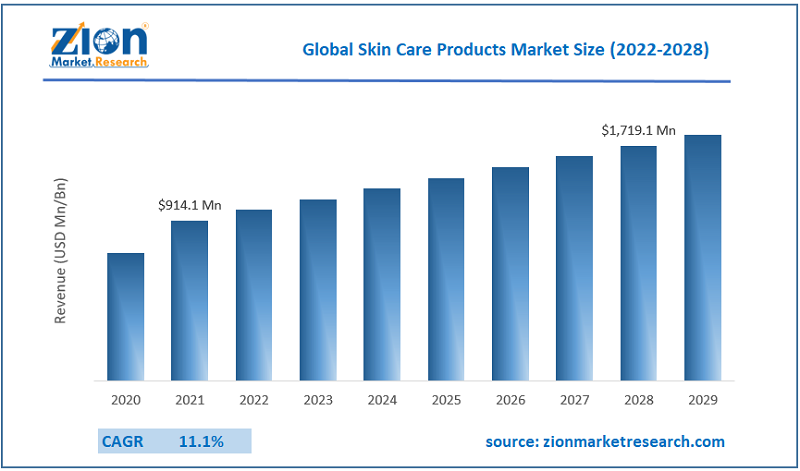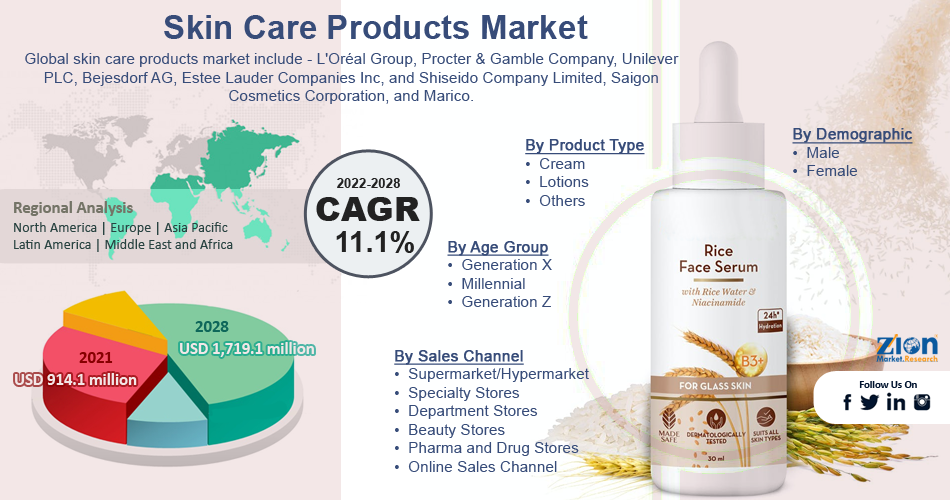Global Skin Care Products Market Size, Share, Growth Analysis Report - Forecast 2034

Skin Care Products Market By Product Type (Face Cream (Skin Brightening Cream, Anti-Aging Cream, Sun Protection Cream), Body Lotion, Face Wash, Others), By End User (Women, Men), Price Point (Mass, Premium), Distribution Channel (Supermarkets/Hypermarkets, Specialty Stores, Online Channels, Others), and By Region: Global and Regional Industry Overview, Market Intelligence, Comprehensive Analysis, Historical Data, and Forecasts 2025 - 2034
| Market Size in 2024 | Market Forecast in 2034 | CAGR (in %) | Base Year |
|---|---|---|---|
| USD 108.58 Billion | USD 167.01 Billion | 4.4% | 2024 |
Skin Care Products Market: Industry Perspective
The global skin care products market size was worth around USD 108.58 Billion in 2024 and is predicted to grow to around USD 167.01 Billion by 2034 with a compound annual growth rate (CAGR) of roughly 4.4% between 2025 and 2034.
The report analyzes the global skin care products market's drivers, restraints/challenges, and the effect they have on the demands during the projection period. In addition, the report explores emerging opportunities in the skin care products industry.
Global Skin Care Products Market: Overview
Skincare products refer to products that relieve skin conditions and improve skin integrity, thereby enhancing appearance. Different skin care products are available in the market, including masks, creams, serums, and lotions. These products are produced using medicinal herbs, natural ingredients, and chemical compounds. Rising awareness regarding the benefits of skincare and self-care among consumers has increased the adoption of organic skin care products. An increase in purchasing power of end consumers and the rise in the young population are the major factors that will drive the growth of the global skin care products market.
Moreover, the increase in smartphone and internet penetration has positively impacted the sales of skin care products by offering multiple benefits to consumers, such as easy price comparisons, heavy discounts, doorstep delivery, and the availability of more variety. These factors collectively have increased the demand for skin care products among consumers.
Key Insights
- As per the analysis shared by our research analyst, the global skin care products market is estimated to grow annually at a CAGR of around 4.4% over the forecast period (2025-2034).
- Regarding revenue, the global skin care products market size was valued at around USD 108.58 Billion in 2024 and is projected to reach USD 167.01 Billion by 2034.
- The skin care products market is projected to grow at a significant rate due to increasing beauty consciousness, aging population, demand for natural and organic products, and influence of social media and celebrity endorsements.
- Based on Product Type, the Face Cream (Skin Brightening Cream segment is expected to lead the global market.
- On the basis of End User, the Women segment is growing at a high rate and will continue to dominate the global market.
- Based on the Price Point, the Mass segment is projected to swipe the largest market share.
- By Distribution Channel, the Supermarkets/Hypermarkets segment is expected to dominate the global market.
- Based on region, Asia-Pacific is predicted to dominate the global market during the forecast period.
Global Skin Care Products Market: Growth Drivers
Rise in young population to drive market growth
The rise in the young population is the major factor that will drive the global skin care products market growth. Gen Z accounts for a major share of 39.1% of the total population. These consumers prefer brands that reflect their attitudes and values. Skin care products have experienced significant adoption among these consumers, as Gen Z is most easily influenced by online advertising.
Global Skin Care Products Market: Restraints
The presence of advanced beauty treatments hinders the market growth
An increase in preference toward advanced beauty treatments such as laser skin rejuvenation, laser resurfacing, microdermabrasion, Thermae, and acne blue light therapy will threaten the growth of the skin care products market.
Global Skin Care Products Market: Opportunities
The development of organic skin care products presents market opportunities
Consumers prefer organic skin care products as they do not contain any side effects and only natural ingredients. At the same time, synthetic products might contain certain chemicals which are not good for the skin. Many key players also focus on developing organic skin care products to gain a competitive advantage.
Global Skin Care Products Market: Challenges
The rise in counterfeit products hinders the market growth
Many regional players are developing counterfeit skin care products that are cost-effective and challenge original skin care products and manufacturers in the market.
Global Skin Care Products Market: Segmentation
The global skin care products market is segregated based on product type, demographic, age group, sales channel, and region.
based on product type, The market is divided into creams, lotions, and others based on product type. Among these, the cream segment dominated the market in 2021, accounting for a major share of total sales. Due to their frequent application, creams are among the most popular products. In addition to providing fast hydration, reducing breakouts, and refreshing the skin, they are a simple, hassle-free, and quick way to treat dry skin. Additionally, as more customers choose cruelty-free skincare products because of their heightened concern for animal welfare and the environment, the demand for vegan or skincare products that combine plant-based components has grown.
Based on demographic, the market is classified into male and female. Over the forecast period, the female segment is expected to dominate the market. Women are increasingly incorporating personal grooming items into their daily routines to boost their self-confidence and looks, significantly boosting the segment's growth. Furthermore, in recent years, women have been inspired by the significance of self-care to intentionally design calming self-care experiences through elaborate skincare routines at home.
Based on age group, the market is classified into generation X, millennials, and generation Z. The millennial segment dominated the market in 2021, accounting for a major share of the revenue. Millennials constitute a major portion of the global population, and consumption of skin care products is also high among millennials.
Based on sales channels, the market is segmented as supermarkets/hypermarkets, specialty stores, department stores, beauty stores, pharma and drug stores, and online sales channels. The supermarket/hypermarket segment held a major share of around 29% in the global skin care products market based on the sales channel in 2021. Supermarkets and hypermarkets are ideal venues for all types of customers since they provide important benefits to customers like choice, reduced pricing, and high visibility of worldwide brands. Supermarkets and hypermarkets are great places to buy skincare items for all sorts of clients since they provide important benefits to customers like freedom of choice, lower pricing, and high visibility of international brands.
Skin Care Products Market: Report Scope
| Report Attributes | Report Details |
|---|---|
| Report Name | Skin Care Products Market |
| Market Size in 2024 | USD 108.58 Billion |
| Market Forecast in 2034 | USD 167.01 Billion |
| Growth Rate | CAGR of 4.4% |
| Number of Pages | 210 |
| Key Companies Covered | L’Oréal S.A., The Estée Lauder Companies Inc., Unilever, Johnson & Johnson, Beiersdorf AG, Shiseido Company, Limited, Amorepacific Corporation, Procter & Gamble, Colgate-Palmolive Company, Kao Corporation, and others. |
| Segments Covered | By Product Type, By End User, By Price Point, By Distribution Channel, and By Region |
| Regions Covered | North America, Europe, Asia Pacific (APAC), Latin America, The Middle East and Africa (MEA) |
| Base Year | 2024 |
| Historical Year | 2020 to 2023 |
| Forecast Year | 2025 - 2034 |
| Customization Scope | Avail customized purchase options to meet your exact research needs. Request For Customization |
Recent Developments
- July 2022: Caudalie, a French beauty product brand, announced an investment in the Asia Pacific region to expand its market in the Asia Pacific.
- July 2022: Azelis and Green Mountain Biotech signed a distribution agreement to strengthen their presence in Southeast Asian countries like Vietnam, Thailand, and Singapore.
Skin Care Products Market: Regional Analysis
The Asia Pacific dominated the global skin care products market in 2021
The Asia Pacific is the leading market in 2021 and account for a major share of global sales. South Korea holds the largest share of skin care product exports, with a major market share in the global market. Korean brands are consistently expanding in terms of the number of consumers, predominantly in the skin care products segments. Around 90% of cosmetics products are imported from foreign brands in the Asia Pacific, such as Shiseido, Fendi, Esteé Lauder, Lancome, L'Oreal, and Clarins. Moreover, local cosmetics brands such as Lana, Thorakao, Biona, and Sao Thái Duonga are focusing on strengthening their position in the market.
Skin Care Products Market: Competitive Analysis
The report provides a company market share analysis to give a broader overview of the key market players. In addition, the report also covers key strategic developments of the market, including acquisitions & mergers, new product launches, agreements, partnerships, collaborations & joint ventures, research & development, and regional expansion of major participants involved in the skin care products market on a global and regional basis.
The global skin care products market is dominated by players like:
- L’Oréal S.A.
- The Estée Lauder Companies Inc.
- Unilever
- Johnson & Johnson
- Beiersdorf AG
- Shiseido Company
- Limited
- Amorepacific Corporation
- Procter & Gamble
- Colgate-Palmolive Company
- Kao Corporation
The global skin care products market is segmented as follows;
By Product Type
- Face Cream (Skin Brightening Cream
- Anti-Aging Cream
- Sun Protection Cream)
- Body Lotion
- Face Wash
- Others
By End User
- Women
- Men
By Price Point
- Mass
- Premium
By Distribution Channel
- Supermarkets/Hypermarkets
- Specialty Stores
- Online Channels
- Others
By Region
- North America
- The U.S.
- Canada
- Mexico
- Europe
- France
- The UK
- Spain
- Germany
- Italy
- Rest of Europe
- Asia Pacific
- China
- Japan
- India
- Australia
- South Korea
- Rest of Asia Pacific
- The Middle East & Africa
- Saudi Arabia
- UAE
- Egypt
- Kuwait
- South Africa
- Rest of the Middle East & Africa
- Latin America
- Brazil
- Argentina
- Rest of Latin America
Table Of Content
Methodology
FrequentlyAsked Questions
The global skin care products market is expected to grow due to rising beauty consciousness, aging populations, and growing demand for natural and anti-aging products.
According to a study, the global skin care products market size was worth around USD 108.58 Billion in 2024 and is expected to reach USD 167.01 Billion by 2034.
The global skin care products market is expected to grow at a CAGR of 4.4% during the forecast period.
Asia-Pacific is expected to dominate the skin care products market over the forecast period.
Leading players in the global skin care products market include L’Oréal S.A., The Estée Lauder Companies Inc., Unilever, Johnson & Johnson, Beiersdorf AG, Shiseido Company, Limited, Amorepacific Corporation, Procter & Gamble, Colgate-Palmolive Company, Kao Corporation, among others.
The report explores crucial aspects of the skin care products market, including a detailed discussion of existing growth factors and restraints, while also examining future growth opportunities and challenges that impact the market.
RelatedNews
HappyClients
Zion Market Research
Tel: +1 (302) 444-0166
USA/Canada Toll Free No.+1 (855) 465-4651
3rd Floor,
Mrunal Paradise, Opp Maharaja Hotel,
Pimple Gurav, Pune 411061,
Maharashtra, India
Phone No +91 7768 006 007, +91 7768 006 008
US OFFICE NO +1 (302) 444-0166
US/CAN TOLL FREE +1 (855) 465-4651
Email: sales@zionmarketresearch.com
We have secured system to process your transaction.
Our support available to help you 24 hours a day, five days a week.
Monday - Friday: 9AM - 6PM
Saturday - Sunday: Closed






